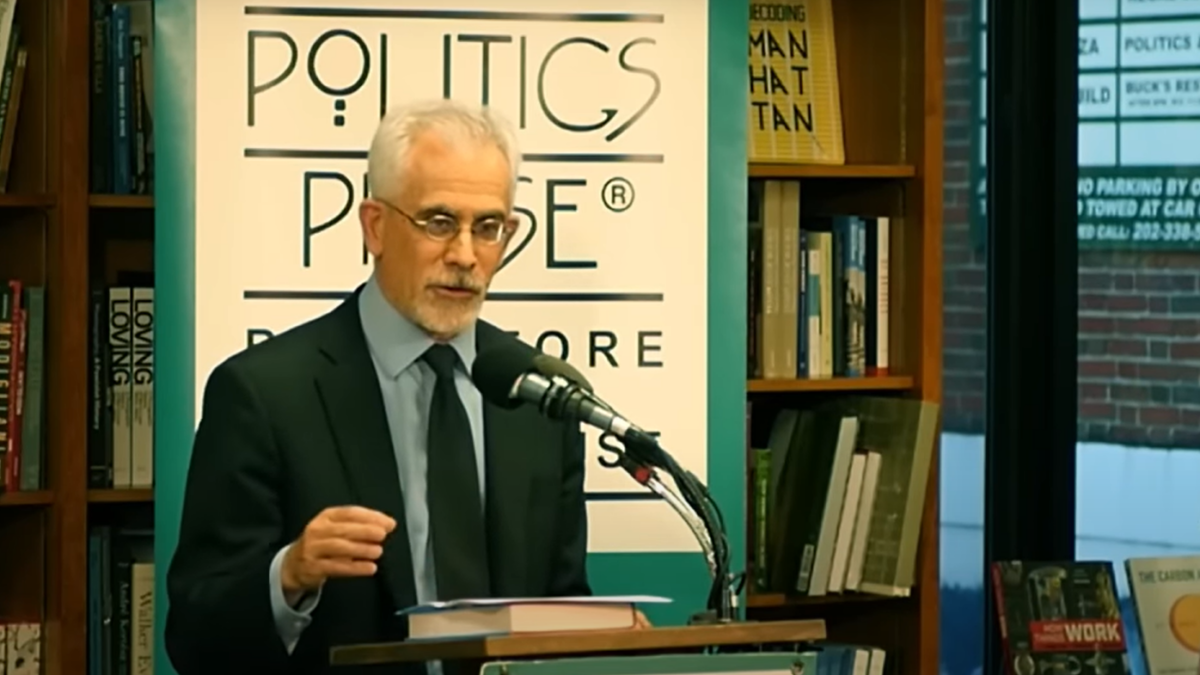I suppose it was a fool’s errand to expect anything remotely close to a true historical inquiry when I picked up David Corn’s “American Psychosis: A Historical Investigation of How the Republican Party Went Crazy.”
Not only should the subtitle have made this abundantly clear, but expecting the Washington bureau chief of Mother Jones and the Steel Dossier/Russiagate conspiracy theorist who broke the story to act in good faith when describing the Republican Party seems, in hindsight, a possible brief slip into psychosis myself. This is nothing new, however, among those in the Fourth Estate. In fact, one would have to go back over a half-century to find the origins of Corn’s faux history.
It was November of 1964 when the American historian and political thinker Richard Hofstadter penned his famed “The Paranoid Style in American Politics” in Harper’s magazine.
The purpose was simple. In the wake of the failed Barry Goldwater presidential run, many political philosophers deemed Goldwater’s stark brand of conservativism as alien, dangerous, and even antithetical to American tradition. Some, with Hofstadter foremost among them (at least from a historical perspective), believed they could trace the elements of his conservative message to some dark, putrid corner of America’s more conspiratorial past.
Using anti-Masonic and anti-Catholic political groups of the late 18th through the 19th century, along with those consumed by the belief that an international cabal of bankers or Illuminati were secretly undermining the United States’ standing on the world stage, he cobbled together a distorted ideological history for the modern conservative movement in America.
To be clear, Hofstadter was not demonizing the entirety of the Republican Party, nor was he indicting conservativism as a whole. Rather, he attempted to pinpoint certain fringe strains within the conservative movement as outside the accepted liberal tradition.
This “accepted” liberal tradition of political homogeneity had been put forth a decade earlier by prominent academics like Lionel Trilling, Arthur Schlesinger Jr., and Louis Hartz, who all posited that the only feasible political ideology by the second half of the 20th century was, in fact, liberalism.
The liberal ideal focused on Lockean ideals forming an opposition to feudalism and authoritarianism, a consensus around property rights, social mobility, individual freedom, and popular democracy. Liberalism permeated nearly all aspects of academia and the political ethos of the era.
At the time, Hofstadter seemed to be writing a causa mortis of a movement or political party many believed to be suffering death throes. Hindsight being 20/20, this was anything but the truth.
Conservativism came to dominate much of the latter half of the 20th century. Some historians, like George Nash, have even argued that conservativism became one of the defining factors of the 20th century. But the narrative that the Republican Party harbored kooks and crazies persisted. And this notion, in a looser contemporary form, is the basis for David Corn’s recent work “American Psychosis.”
To begin, calling it a historical “investigation” is a disservice to historians and those closely acquainted with the field. His work attempts a chronological narrative in which he tries to show how every conservative leader since Goldwater defended and “depended on racists, bigots, or extremists to chart their ways to the White House.”
He not only lacks evidence but bases his idea on a questionable methodology. He argues that Republican leaders did not anachronistically call out every instance of supposed moral impropriety, proving that they implicitly approved of those on the fringes of the party.
From Corn’s standpoint, every national Republican political leader promoted racism and homophobia, endorsed extremism, courted Nazis, and actively tried to create a religious war between Christians and secularists.
Forget legislation and public policy. Ignore debates over domestic economic affairs or foreign policy. Avoid any mention of the purges that occurred within the ranks of conservatism during the 20th century and the contentious intellectual battle for the soul of conservatism that occurred in the ranks at National Review, among those gathered at the Philadelphia Society, and within various think tanks such as the American Enterprise Institute, the Intercollegiate Studies Institute, or The Heritage Foundation.
No, according to Corn, everything must be viewed and judged through the all-seeing eye of contemporary cultural norms. Race, gender, sexuality, and the contemporary standard of political correctness must be upheld in both the present and the past.
This may well be a journalistic op-ed on what Corn considered wrong with the Republican Party of the last 60 or so years, but a history it is not.
The first two chapters have a meandering resemblance to Hofstadter’s central tenets from both “The Paranoid Style” and “Anti-Intellectualism in American Life,” where he argued America has always had a conspiratorial mythos and that during the 20th century, the Republican Party became the predominant home and outlet for such people and views. Moving forward, he continues to peel off Hofstadter’s points in “The Paranoid Style” by zeroing in on the one name Hofstadter mentioned most after Joseph McCarthy: Robert Welch.
Robert Welch and The Birch Society or Birchers were the seminal villains in “Paranoid Style” and monopolize the first quarter of Corn’s work. He, like the recent authors of “A Conspiratorial Life: Robert Welch, the John Birch Society, and the Revolution of American Conservatism” and “Birchers: How the John Birch Society Radicalized the American Right,” afford far too much influence to this relatively small group in the shaping of conservative orthodoxy and the Republican Party. Corn saw a Bircher behind every maligned motive or conspiratorial idea in the 1950s through the 1970s.
The rest of the book follows a similar pattern. In each chapter, there is a Republican leader (Reagan, Bush, Gingrich, McCain, etc.,) along with those who, in Corn’s eyes, were more dubious individuals (Jerry Falwell, Pat Robertson, Rush Limbaugh, Glenn Beck, Steve Bannon) whom he believed to be associated with either racism, Christian nationalism, or conspiracy theories.
Each chapter overreaches into haphazard conclusions, such as: “Nixon kept racism alive within the GOP,” “Reagan … would hobnob with haters, extremists, racists, neo-Nazis (yes, neo-Nazis), and purveyors of … absurd conspiracy theories,” and George H.W. Bush “set a new bottom for the Republican Party” with his “down and dirty [campaign] strategy,” and so on and so on. This carries on for a couple of hundred pages.
As an astute reader might imagine, Corn’s work culminates with the “narcissistic, disruptive, divisive, demonizing, [and] confrontational” Trump presidency. While his disdain for Trump is evident from the introduction and clearly articulated in the last two and a half chapters, he clarified that the book’s true villain is now the Republican Party and its voters.
The voters were not only to blame for Jan. 6 and all the ills plaguing Western society, but “their fervor was the real threat to the nation.” The Republican Party is no longer to be tolerated but has become “a threat to the republic,” whose one mission is to “sabotage democracy.”
Corn’s work is not history. It is a shoddy attempt at anthropological research. Like those who wander into the wilderness to observe some alien indigenous peoples, he too is an interloper who, though he may try to observe and comprehend his subject, never attempts to truly understand the people or ideology he writes about.
This is evident in many ways. First, he approaches his subject with overwhelming disdain. Even historians who write about the evils of the 20th century still manage to find some sense of humanity and empathy in their subject matter. (See John Lukacs “The Hitler of History” or Stephen Kotkin’s multivolume “Stalin“).
Second, his seeming ignorance of the historiography associated with his subject matter and the limited sources utilized indicate the difference between journalism and history.
Finally, Corn began his research with his mind already made up. He never sought new insights by analyzing underutilized primary sources or brought a new way of understanding to the field by refocusing or reorganizing the way in which we understand certain concepts about the Republican Party. No, Corn wanted to show how the Republican Party is evil for contemporary political purposes. This is antithetical to the field of history.
In the end, he chose to forgo nuance and instead condemn aspects that to him seem so unfamiliar and separated from the expected liberal orthodoxy. He treats things he does not understand as if they must signify some ethereal danger to be squashed underfoot.
Unlike Hofstadter, where the Republican Party was only the bulwark behind which certain fringes hid, now Corn argues that the party itself, its followers, and all associated with it need to be purged. American psychosis indeed.









